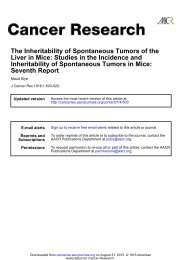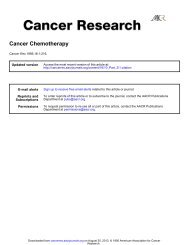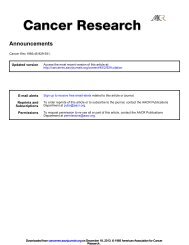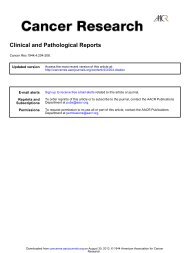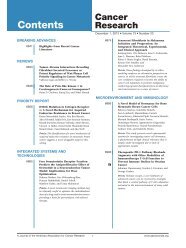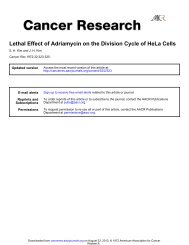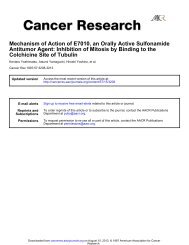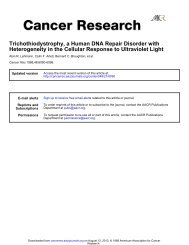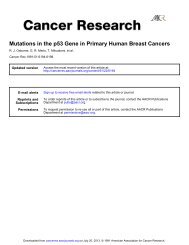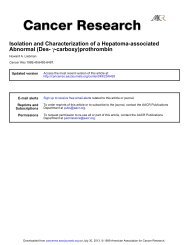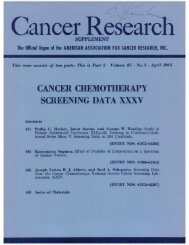Thyroid Hormone in 7,12-Dimethylbenz(a ... - Cancer Research
Thyroid Hormone in 7,12-Dimethylbenz(a ... - Cancer Research
Thyroid Hormone in 7,12-Dimethylbenz(a ... - Cancer Research
Create successful ePaper yourself
Turn your PDF publications into a flip-book with our unique Google optimized e-Paper software.
<strong>Thyroid</strong> <strong>Hormone</strong> <strong>in</strong> 7,<strong>12</strong>-<strong>Dimethylbenz</strong>(a)anthracene-<strong>in</strong>duced<br />
Leukemia <strong>in</strong> Rats<br />
Alan K. Burnett<br />
<strong>Cancer</strong> Res 1979;39:4252-4255.<br />
Updated version<br />
Access the most recent version of this article at:<br />
http://cancerres.aacrjournals.org/content/39/10/4252<br />
E-mail alerts Sign up to receive free email-alerts related to this article or journal.<br />
Repr<strong>in</strong>ts and<br />
Subscriptions<br />
Permissions<br />
To order repr<strong>in</strong>ts of this article or to subscribe to the journal, contact the AACR Publications<br />
Department at pubs@aacr.org.<br />
To request permission to re-use all or part of this article, contact the AACR Publications<br />
Department at permissions@aacr.org.<br />
Downloaded from<br />
cancerres.aacrjournals.org on March 23, 2013. © 1979 American Association for <strong>Cancer</strong> <strong>Research</strong>.
[CANCER RESEARCH 39. 4252-4255, October 1979)<br />
0008-5472/79/0039-OOOOS02 00<br />
<strong>Thyroid</strong> <strong>Hormone</strong> <strong>in</strong> 7,<strong>12</strong>-<strong>Dimethylbenz</strong>(a)anthracene-<strong>in</strong>duced Leukemia <strong>in</strong><br />
Rats1<br />
Alan K. Burnett2<br />
The Ben May Laboratory for <strong>Cancer</strong> <strong>Research</strong>. University of Chicago, Chicago. Ill<strong>in</strong>ois 60637<br />
ABSTRACT<br />
<strong>Thyroid</strong>ectomy reduces the <strong>in</strong>cidence of hormone-depend<br />
ent stem cell leukemia elicited by 4 biweekly doses of 7,<strong>12</strong>dimethylbenz(a)anthracene<br />
to Long-Evans rats (22% com<br />
pared with 46% <strong>in</strong> control animals). There is a high <strong>in</strong>cidence<br />
of early death due to aplastic anemia <strong>in</strong> the thyroidectomized<br />
rats (70%) compared with controls (34%). In established leu<br />
kemia, neither thyroidectomy nor thyrox<strong>in</strong>e excess produces<br />
any last<strong>in</strong>g benefit. In all experiments, the thyroid status of<br />
each rat is cont<strong>in</strong>uously measured by the free thyrox<strong>in</strong>e <strong>in</strong>dex.<br />
INTRODUCTION<br />
A stem cell leukemia can be <strong>in</strong>duced rapidly by a series of<br />
P.O. feed<strong>in</strong>gs of DMBA3 to Long-Evans rats (8). A remarkable<br />
feature of this leukemia is its rapid regression follow<strong>in</strong>g hypo-<br />
physectomy <strong>in</strong> substantial numbers of rats with primary leuke<br />
mia or bear<strong>in</strong>g transplants of leukemia cells (7,11,19).<br />
Which s<strong>in</strong>gle hormone or comb<strong>in</strong>ation of hormones under<br />
pituitary control is responsible for this effect is not known.<br />
Prolact<strong>in</strong> has been found to be unimportant <strong>in</strong> the <strong>in</strong>duction<br />
time and <strong>in</strong>cidence of this leukemia (1, 20).<br />
The activity of the thyroid gland is under trophic <strong>in</strong>fluence of<br />
the pituitary and it is now well established that thyroid hormone<br />
markedly affects the oxidative metabolism of cells (3). Thus, it<br />
seems possible that <strong>in</strong>terference with thyroid gland activity may<br />
be responsible for the pituitary ablative effect on leukemic cell<br />
growth. Previous <strong>in</strong>vestigations of the role of the thyroid <strong>in</strong> the<br />
development and growth of tumors have been sporadic, and<br />
the results have been conflict<strong>in</strong>g. On one hand, some workers<br />
(4, 6, <strong>12</strong>, 13, 15, 21 ) found that alteration <strong>in</strong> the thyroid status<br />
<strong>in</strong>fluenced the <strong>in</strong>duction and rate of growth of a variety of<br />
tumors <strong>in</strong>clud<strong>in</strong>g leukemias, whereas others (14, 18) could<br />
demonstrate little <strong>in</strong>fluence of thyroid hormone on tumor<br />
growth.<br />
In none of these studies, however, was the thyroid status<br />
monitored dur<strong>in</strong>g the period when altered hormone levels were<br />
assumed to be present. This paper, therefore, represents the<br />
first controlled study of the <strong>in</strong>fluence of thyroid activity on the<br />
<strong>in</strong>duction and ma<strong>in</strong>tenance of a hydrocarbon-<strong>in</strong>duced leukemia<br />
where hormone levels have been carefully monitored through<br />
out the period of experimental observation.<br />
MATERIALS AND METHODS<br />
Animals. Long-Evans rats were studied exclusively. They<br />
' Supported pr<strong>in</strong>cipally by grants from the American <strong>Cancer</strong> Society and the<br />
Jane Coff<strong>in</strong>s Childs Memorial Fund for Medical <strong>Research</strong>, by USPHS <strong>Research</strong><br />
Grant CA 11603 from the National <strong>Cancer</strong> Institute, and laterally by The Leukemia<br />
<strong>Research</strong> Fund<br />
' Present address: Department of Haematology, Glasgow Royal Infirmary,<br />
Glasgow, G4 OSF. Scotland.<br />
' The abbreviation used is: DMBA, 7.<strong>12</strong>-dimethylbenz(a)anthracene.<br />
Received May 25. 1976; accepted July 19, 1979<br />
were taken from a random-bred closed colony of rats which<br />
has been ma<strong>in</strong>ta<strong>in</strong>ed for 14 years. The rats were housed <strong>in</strong><br />
sta<strong>in</strong>less steel or plastic cages <strong>in</strong> air-conditioned rooms at 25<br />
±1°(S.D.), artificially lit for <strong>12</strong> hr/day. They were fed com<br />
mercial ration [Rockland Mouse/Rat diet (Teklad, Monmouth,<br />
III.) or Diet 41 (William Shearer Ltd., Glasgow, Scotland)]. Tap<br />
water was given freely. Ether was used as anesthetic when<br />
required. Vag<strong>in</strong>al smears were exam<strong>in</strong>ed daily.<br />
Induction of Leukemia. In experiments to assess the effect<br />
of thyroidectomy on the <strong>in</strong>duction of leukemia, a 15% (w/v)<br />
emulsion of DMBA (k<strong>in</strong>dly supplied by Dr. Paul Schurr, The<br />
Upjohn Company, Kalamazoo, Mich.) was <strong>in</strong>jected <strong>in</strong>to the tail<br />
ve<strong>in</strong> of 44- to 54-day-old rats (designated Day 0). This was<br />
repeated on a further 3 occasions at 14-day <strong>in</strong>tervals; the dose<br />
was fixed at 30 mg/kg body weight. In experiments on estab<br />
lished leukemia, the leukemia was <strong>in</strong>duced by p.o. adm<strong>in</strong>istra<br />
tion of a solution of ref<strong>in</strong>ed 0.5% (w/v) DMBA <strong>in</strong> sesame oil, as<br />
described previously (11), to animals ages 28 to 35 days <strong>in</strong> a<br />
dose of 175 mg/kg body weight, and on 3 further occasions<br />
at 14-day <strong>in</strong>tervals <strong>in</strong> a dose of 10 mg to each rat.<br />
Diagnosis of Leukemia. The most convenient method of<br />
early diagnosis of this leukemia is its appearance on open liver<br />
biopsy as described earlier (8). The first diagnostic liver biopsy<br />
was performed 14 days after the f<strong>in</strong>al exposure to carc<strong>in</strong>ogen<br />
(i.e., Day 56), and on a further 7 occasions at 14-day <strong>in</strong>tervals<br />
thereafter.<br />
Hematological Studies. Blood for hematological procedures<br />
was obta<strong>in</strong>ed by cardiac puncture <strong>in</strong>to a hepar<strong>in</strong>ized syr<strong>in</strong>ge<br />
and exam<strong>in</strong>ed by conventional hematological techniques.<br />
Erythropoiesis was estimated by 59Fe uptake <strong>in</strong>to bone marrow<br />
2 hr after <strong>in</strong>jection of a dose of 1 juCi/g body weight (17).<br />
<strong>Thyroid</strong>ectomy. Thyroparathyroidectomy was performed by<br />
surgical avulsion. In <strong>in</strong>duction experiments, this preceded the<br />
first dose of carc<strong>in</strong>ogen by 6 to 7 days <strong>in</strong> all cases. All<br />
thyroparathyroidectomized rats were given 1% calcium lactate<br />
<strong>in</strong> the dr<strong>in</strong>k<strong>in</strong>g water to avoid tetany. Completeness of thyroid<br />
ectomy was assessed by assay of the free thyrox<strong>in</strong>e <strong>in</strong>dex.<br />
This <strong>in</strong>dex is derived from multiply<strong>in</strong>g the product of the free<br />
thyrox<strong>in</strong>e level (jug/100 ml), based on a competitive b<strong>in</strong>d<strong>in</strong>g<br />
technique (16), and the ratio of the uptake of thyrox<strong>in</strong>e onto<br />
res<strong>in</strong> beads compared with standard sera. Serum from all<br />
animals was assessed at approximately 6 weekly <strong>in</strong>tervals.<br />
Assay of 85 normal rats established a normal range of 5.46<br />
± 1.46 (S.D.). <strong>Thyroid</strong>ectomy was considered <strong>in</strong>complete if<br />
the free thyrox<strong>in</strong>e <strong>in</strong>dex was greater than 1.0. L-Thyrox<strong>in</strong>e<br />
(Sigma Chemical Co., St. Louis, Mo.) was adm<strong>in</strong>istered <strong>in</strong> a<br />
dose of 10 fig/day s.c.<br />
RESULTS<br />
Anatomical and Hematological Effects of <strong>Thyroid</strong>ectomy.<br />
Female rats were used for this study. <strong>Thyroid</strong>ectomy was<br />
performed at age 21 days. The animals became sluggish,<br />
4252 CANCER RESEARCH VOL. 39<br />
Downloaded from<br />
cancerres.aacrjournals.org on March 23, 2013. © 1979 American Association for <strong>Cancer</strong> <strong>Research</strong>.
developed coarse fur, and showed retardation of body growth<br />
(Chart 1). Open<strong>in</strong>g of the vag<strong>in</strong>al plate was not delayed, and<br />
periodicity of the estrus cycle was normal. A mild nonprogres<br />
sive anemia developed around the 35th postthyroidectomy<br />
day. No persistent significant differences <strong>in</strong> peripheral WBC or<br />
platelet count were noted. At the 77th postthyroidectomy day,<br />
a small but significant reduction (p < 0.05) <strong>in</strong> spleen size was<br />
observed: 0.18 ± 0.02 versus 0.21 ± 0.01 g/100 g body<br />
weight (10 rats <strong>in</strong> each group).<br />
Erythropoiesis as measured by 59Fe <strong>in</strong>corporation <strong>in</strong>to bone<br />
marrow 77 days postthyroidectomy was significantly reduced<br />
( p < 0.05) <strong>in</strong> the thyroidectomized group (1148 ±324 versus<br />
1773 ±402 cpm, wet weight, bone marrow; 8 rats <strong>in</strong> each<br />
group).<br />
The Effect of <strong>Thyroid</strong>ectomy on Induction of Leukemia. In<br />
the series of experiments to assess the effect of hypothyroidism<br />
on the <strong>in</strong>duction of leukemia, 21 7 adequately thyroidectomized<br />
rats and 138 <strong>in</strong>tact littermates were given 4 doses of carc<strong>in</strong>o<br />
gen at biweekly <strong>in</strong>tervals. Two major effects were noted.<br />
First, there was a significantly higher <strong>in</strong>cidence of early death<br />
<strong>in</strong> the thyroidectomized group, compared with controls. Only<br />
45 of the orig<strong>in</strong>al 219 thyroidectomized animals became "ef<br />
fective," i.e., survived until the day of the first diagnostic liver<br />
biopsy (Day 56), compared with 90 of 138 controls (p <<br />
0.001).<br />
The majority of deaths occurred follow<strong>in</strong>g the second or third<br />
<strong>in</strong>jection of carc<strong>in</strong>ogen and appeared to be due, <strong>in</strong> the majority<br />
of cases, to aplastic anemia. This was characterized by loss of<br />
body weight, loss of normal estrus periodicity <strong>in</strong> females,<br />
reduced body temperature, peripheral blood pancytopenia,<br />
and marrow hypoplasia or aplasia.<br />
Second, of the 45 "effective" thyroidectomized animals, 10<br />
42<br />
49<br />
3»<br />
36<br />
34<br />
32<br />
30<br />
28<br />
Hematocrit Platelets<br />
/ *<br />
7 14 21 28 35 42 49 56 63 70 77<br />
day «•<br />
13,000+ Leukocytes<br />
7 14 21 28 35 42 49 56<br />
j<br />
<strong>Thyroid</strong> <strong>Hormone</strong> In <strong>Hormone</strong>-dependent Leukemia<br />
(22%) developed leukemia by Day 140 compared with 41<br />
(46%) of the 90 "effective" controls (p < 0.01) (Table 1).<br />
S<strong>in</strong>ce several animals from each group succumbed to the<br />
stress of repeated diagnostic liver biopsy, the <strong>in</strong>cidence of<br />
leukemia was assessed on each biopsy day (Table 1). There<br />
was a statistically significant difference (p < 0.05) on Day 56,<br />
but on each other day the differences failed to achieve signifi<br />
cance. However, the total number of rats develop<strong>in</strong>g leukemia<br />
by Days 56, 70, 84, 98, and 1<strong>12</strong> was significantly greater <strong>in</strong><br />
controls compared with thyroidectomized rats (Day 56, p <<br />
0.06; Day 70, p < 0.05; Day 84, p < 0.01 ; Day 98, p < 0.05,<br />
Day 1<strong>12</strong>, p < 0.01).<br />
There were no significant differences <strong>in</strong> the time taken to<br />
develop leukemia between the groups (thyroidectomy, 91 ±<br />
29 days; controls, 78 ±26 days). The statistical test used <strong>in</strong><br />
these experiments was x? with Yates correction for small num<br />
bers.<br />
Effect of <strong>Thyroid</strong>ectomy on Stem Cell Leukemia. None of<br />
the animals with established primary leukemia which were<br />
subjected to thyroidectomy showed any reduction <strong>in</strong> growth of<br />
leukemia. In every case, peripheral blood values deteriorated,<br />
and liver biopsy on the 14th postoperative day exhibited more<br />
extensive <strong>in</strong>filtration than preoperatively (Table 2). Survival <strong>in</strong><br />
the thyroidectomized animals was shorter (21 ±9.9 days) than<br />
<strong>in</strong> controls (29.4 ±14.0 days).<br />
Effect of Thyrox<strong>in</strong>e Excess on Stem Cell Leukemia. Of the<br />
20 animals with primary leukemia that received large doses of<br />
thyrox<strong>in</strong>e, 18 showed clear deterioration (Table 3). Peripheral<br />
blood values had deteriorated, and liver histology exhibited<br />
marked deterioration. Two animals, however, showed improve<br />
ment <strong>in</strong> peripheral blood <strong>in</strong>dices. In these cases, liver biopsy<br />
showed apparent complete regression <strong>in</strong> one, and partial<br />
28 35 42 49 56 63 70 77<br />
7 14 21 28 35 42 49 56 63 70 77<br />
Chart 1. The effect of thyroidectomy on peripheral blood and body weight. <strong>Thyroid</strong>ectomy performed at 21 days of age (Day 0). Each po<strong>in</strong>t is the mean of 8<br />
nalpK<br />
females<br />
OCTOBER 1979 4253<br />
Downloaded from<br />
cancerres.aacrjournals.org on March 23, 2013. © 1979 American Association for <strong>Cancer</strong> <strong>Research</strong>.
A. K. Burnett<br />
Table 1<br />
Ellect of thyroidectomy on <strong>in</strong>duction ol stem cell leukemia<br />
<strong>Thyroid</strong>eclomized rats were given DMBA, 30 mg/kg, on 4 occasions at 14-day <strong>in</strong>tervals commenc<strong>in</strong>g at age 44 to<br />
54 days Rats surviv<strong>in</strong>g until the first diagnostic liver biopsy (Day 56) are termed effective" rats<br />
<strong>Thyroid</strong>ectomy<br />
ControlInitial<br />
1/13ap
The metabolism of DMBA may be retarded <strong>in</strong> thyroidecto-<br />
mized animals, permitt<strong>in</strong>g its toxic effects on the bone marrow<br />
to be enhanced. Hypothyroidism is known to <strong>in</strong>hibit hepatic<br />
pyrid<strong>in</strong>e nucleotide-l<strong>in</strong>ked dehydrogenases (10). Adm<strong>in</strong>istra<br />
tion of DMBA causes an <strong>in</strong>crease <strong>in</strong> hepatic menadione reductase<br />
(9). Our <strong>in</strong>itial experiments, however, <strong>in</strong>dicate that the<br />
<strong>in</strong>crease <strong>in</strong> the hepatic level of this enzyme follow<strong>in</strong>g adm<strong>in</strong>is<br />
tration of carc<strong>in</strong>ogen is no different <strong>in</strong> hypothyroid animals.<br />
Investigation of this aspect cont<strong>in</strong>ues.<br />
ACKNOWLEDGMENTS<br />
The author is deeply <strong>in</strong>debted to Dr. Charles Mugg<strong>in</strong>s of the Ben May<br />
Laboratory. University of Chicago, for his k<strong>in</strong>dness and encouragement with this<br />
work. He also wishes to thank Dr. Leslie De Groot, The <strong>Thyroid</strong> Study Group.<br />
University of Chicago, and Wendy Radcliffe. Department of Biochemistry. Glas<br />
gow Royal Infirmary, Scotland, for facilities to measure thyroid status.<br />
REFERENCES<br />
1. Aida, M. The effect of pituitary hormones on 7.1 2-dimethylbenz(a)anthracene-<strong>in</strong>duced<br />
rat leukemia. Wakayama Med. Rep.. Ã6.57-76. 1974<br />
2. Bird. C. C. Leukemia <strong>in</strong>duced by 7.8.<strong>12</strong>-trimethylbenz(a)anthracene <strong>in</strong> rats.<br />
II. Changes <strong>in</strong> Bone Marrow. J. Nati. <strong>Cancer</strong> Inst., 48: 429-439. 1972.<br />
3. Burgi, H., and Labhart. A. In: A. Labhart (ed.). The <strong>Thyroid</strong> Gland, Spr<strong>in</strong>ger-<br />
Verlag, pp. 135-283. New York: 1974.<br />
4. Dargent, M., Viallier, J.. and Gu<strong>in</strong>et. E. Influence de la secretion thyroïdienne<br />
sur la Croissance des tumeurs. Ann. Inst. Pasteur (Paris), 8J. 357-361,<br />
1951.<br />
5. Ford, E., and Mugg<strong>in</strong>s, C. Selective destruction <strong>in</strong> testis <strong>in</strong>duced by 7,<strong>12</strong>dimethylbenz(a)anthracene.<br />
J. Exp. Med.. 118: 27-40. 1963.<br />
6. Grad, B., Oberleitner. A., and Berenson. J. The effect of thyrox<strong>in</strong>e and<br />
thiouracil on thé<strong>in</strong>cidence of lymphogenous leukemia <strong>in</strong> AKR mice. Proc.<br />
Am. Assoc. <strong>Cancer</strong> Res.. J. 20-21. 1953.<br />
7. Hugg<strong>in</strong>s, C. B., and Oka, H. Regression of stem-cell erythroblastic leukemia<br />
Thyro/d <strong>Hormone</strong> In <strong>Hormone</strong>-dependent Leukemia<br />
after hypophysectomy. <strong>Cancer</strong> Res.. 32 239-242. 1972.<br />
8. Hugg<strong>in</strong>s, C. B., and Sugiyama, T. Induction of leukemia <strong>in</strong> rat by pulse doses<br />
of 7,<strong>12</strong>-dimethylbenz(a)anthracene. Proc. Nati. Acad. Sei. U. S. A., 55: 74-<br />
81, 1966.<br />
9. Hugg<strong>in</strong>s, C. B.. Ueda, N., and Russo, A. Azo dyes prevent hydrocarbon<strong>in</strong>duced<br />
leukemia <strong>in</strong> the rat Proc. Nati. Acad. Sei. U. S. A.. 75 4524-4527,<br />
1978.<br />
10. Hugg<strong>in</strong>s, C., and Yao. F-O. Influence of hormones on liver. 1. Effects of<br />
steroids and thyrox<strong>in</strong>e on pryid<strong>in</strong>e nucleotide-l<strong>in</strong>ked dehydrogenases. J.<br />
Exp. Med.. ; 10: 899-919, 1959.<br />
11. Hugg<strong>in</strong>s. C. B., Yoshida, H.. and Bird, C. C. <strong>Hormone</strong>-dependent stem-cell<br />
leukemia evoked by a series of feed<strong>in</strong>gs of 7,<strong>12</strong>-dimethylbenz(a)anthracene<br />
J. Nati. <strong>Cancer</strong> Inst., 52. 1301-1305. 1974.<br />
<strong>12</strong>. Juli, J. W., and Hugg<strong>in</strong>s, C. B. Influence of hyperthyroidism and of thyroidectomy<br />
on <strong>in</strong>duced mammary cancer. Nature (Lond.), 188: 73. 1960.<br />
13. Kreyberg, L. The <strong>in</strong>fluence of <strong>in</strong>tr<strong>in</strong>sic factors on the development of <strong>in</strong>duced<br />
tumors <strong>in</strong> animals. Acta Pathol. Microbiol. Scand. Suppl., 37; 317-338,<br />
1938<br />
14. Morimota, S. Influence of thyroidectomy on tar-epithelioma Acta Dermatol.<br />
Kyoto (Engl. Ed.), )9. 185-186, 1932.<br />
15. Morris. D. M.. Upton, C. A., and Wolf, F. F. The <strong>in</strong>fluence of the thyroid<br />
gland on the susceptibility of AKR mice to transplanted lymphoid leukemia.<br />
Proc. Am. Assoc. <strong>Cancer</strong> Res.. 2 36, 1955.<br />
16. Murphy, B. P.. and Jachan, C. The determ<strong>in</strong>ation of thyrox<strong>in</strong>e by competitive<br />
prote<strong>in</strong>-b<strong>in</strong>d<strong>in</strong>g analysis employ<strong>in</strong>g an anion-exchange res<strong>in</strong> and radiothyrox<strong>in</strong>e.<br />
J. Lab. Cl<strong>in</strong>. Med.. 66. 161-167, 1965.<br />
17. Reddi, A. H.. and Hugg<strong>in</strong>s. C. B. Formation of bone marrow <strong>in</strong> fibroblasttransformation<br />
ossicles. Proc. Nati. Acad. Sei. U. S. A., 72 22<strong>12</strong>-2216.<br />
1975.<br />
18. Solviter, H. A. The effect of complete ablation of thyroid tissue by radioactive<br />
iod<strong>in</strong>e on the survival of tumor-bear<strong>in</strong>g mice. <strong>Cancer</strong> Res.. ) /. 447-449,<br />
1951.<br />
19. Ueda, N., and Hugg<strong>in</strong>s, C B. Regression of experimental leukemias follow<strong>in</strong>g<br />
hypophysectomy. Proc Am. Assoc. <strong>Cancer</strong> Res , 16 13, 1975.<br />
20. Welsch. C. W.. Horowitz. S., and Hugg<strong>in</strong>s. C. B. Influence of prolact<strong>in</strong> on<br />
carc<strong>in</strong>ogen-<strong>in</strong>duced leukemagenesis <strong>in</strong> Long-Evans rats. <strong>Cancer</strong> Res., 35:<br />
3746-3749. 1975.<br />
21. Wolfson. S. L., Drake, J., and Bass. A. D. Effect of athyreosis on the<br />
<strong>in</strong>duction of rat sarcoma with 3-methylcholanthracene. Growth. 20. 19-28,<br />
OCTOBER 1979 4255<br />
Downloaded from<br />
cancerres.aacrjournals.org on March 23, 2013. © 1979 American Association for <strong>Cancer</strong> <strong>Research</strong>.<br />
1956.




